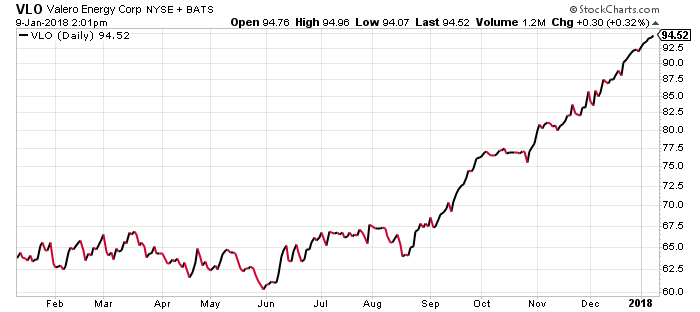Oil Refinery Stocks Rally Should Continue in 2018
It’s 2018, and investors might be surprised to discover that rather than the tech sector, Wall Street continues to rally thanks to messy and old-fashioned oil. All the oil majors perform chemical engineering and oil refining operations, but the specific refiners don’t have to worry about the price of crude oil. That’s why, carrying momentum from 2017, oil refinery stocks in 2018 could continue their bullish course. But beware, that course could end abruptly.
First of all, what are some of the oil refinery stocks in 2018 to follow? Marathon Petroleum Corp (NYSE:MPC), Andeavor (NYSE:ANDV), Phillips 66 (NYSE:PSX), and Valero Energy Corporation (NYSE:VLO) have been some of the best-performing stocks in the refining industry of 2017. Valero, for example, may be the largest independent oil refining company in the world. Valero stock offers a nice cutaway for oil refinery stocks’ “sleeper” but excellent performance in 2017, having gained some 42% since January 2017.

Chart Courtesy of StockCharts.com
Forget tech, that’s defense stock levels of return. Indeed, oil refining stocks were one of the big financial stories of 2017, but everyone was too busy staring at Bitcoin and Tesla Inc (NASDAQ:TSLA) to notice. Oil market analysis tends to focus on the large energy companies–the explorers and extractors like Exxon Mobil Corporation (NYSE:XOM). Exxon stock has lost 0.01% since January 2017. It would have lost more, but the volatile mixture of Middle Eastern, North Korean, and Russiagate politics combined to fuel as volatile and explosive a political risk scenario as a refined petroleum product.
As always, the big concern for investors considering taking up positions in an industry they haven’t been following is not to be the last ones to buy. Those who have enjoyed the oil refiners’ Wall Street ride in 2017, of course, want to know if this is a roller-coaster, and if the big downhill bit is coming up.
Three Factors That Predict a Bull Market for Refining Stocks in 2018
There are three basic factors that suggest the bull cycle for refiners will continue to defy the matadors in the market.
The 2017 Hurricane Season
Hurricanes Harvey, Irma, Jose, and Katia did not only throw people’s lives, homes, and property in disarray in Florida and the Caribbean last September; they also sent the logic of oil investing in 2017 on a wild ride. The natural phenomena in the Atlantic coast caused heavy damage to many crucial refineries, such as Port Arthur in Texas, the largest in the United States. Oil prices rose during the 2017 hurricane season–one of the most intense since the 1990s. They went comfortably above the $50.00 per barrel mark after lingering for most of 2017 in the mid-$40.00 per barrel range. Yet the scarcity was not in the supply and reserves of barrels of crude oil. Rather, it was in the availability of refined crude products.
Even if refining facilities were able to continue producing at close to normal levels, the hurricanes undermined the ability of refined oil networks to function at normal capacity. This means that even if refiners were able to meet U.S. demand for refined oil derivatives, their ability to address the Caribbean and South American markets were compromised. The resulting panic, amid the real disruptions, then caused the refined fuel product shortage to magnify in the public and the markets’ ‘minds. The hurricane effect, given also the enduring problems in Puerto Rico, has persisted. California fires then contributed to the “disaster effect” mentality.
Oil Market Rally and Related Political and Terrorism Risks
But how can this last? The main energy stocks, such as the aforementioned ExxonMobil, have managed to close 2017 generally at similar values to 2016.
Oil prices have managed to surf the $55.00 per barrel range since summer 2017, even as the ISIS threat seemed to have vanished. A few important pipeline explosions in Iran and Libya last December reminded the world that ISIS may have lost a state, but it hasn’t lost its vice.
Meanwhile, Iranians have started to rediscover the tool of political protest. A large revolt has been quelled, but the government will have to manage intense and disruptive privatizations in 2018, which all but guarantee more labor strikes and potential disruptions to oil production. Moreover, Iran lacks refining capacity; increasing it was one of the goals of its pursuit of the nuclear deal, which would have allowed foreign companies to build new refineries. Trump has all but scrapped the nuclear deal, discouraging foreign investment in refining or any other oil industry activity in Iran. This will help reinforce the image of a refining scarcity and sustain the related market valuations.
Economic Growth and the Trump Tax Cuts
Better than natural disasters, the case for bullish oil refining stock prices persisting in 2018 is the promise of economic growth.
Finally, the Trump tax cuts, however problematic and recession-inducing, have contributed to the idea of economic growth. Few economists, including those critical of Trump’s fiscal policy, doubt that the economy will continue to grow for at least the first half of 2018. That perception should sustain families’ propensity to spend and travel, which will generate demand for refined products at the pump. Even if Middle Eastern tensions relax, pushing the price for a barrel of oil down, refiners’ margins will remain at levels strong enough to prolong their bullish performance. Of course, the moment reality sets in, when the tax cuts become merely higher corporate profits rather than growth incentives, the real economy will suffer, dragging oil refinery stocks (and others) with it.






